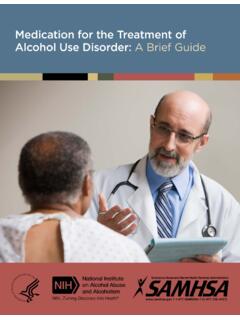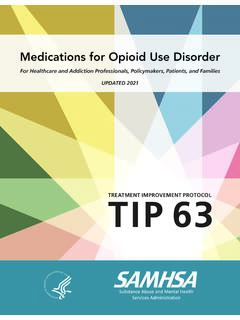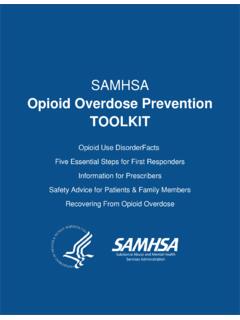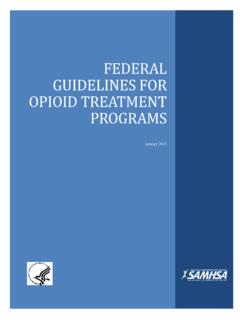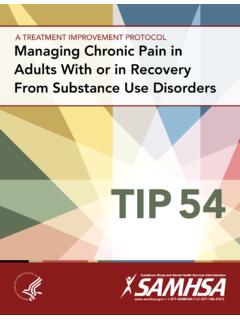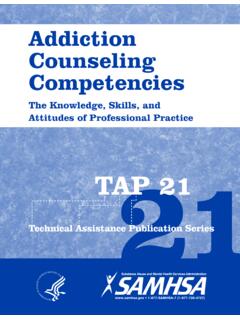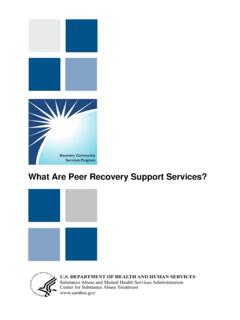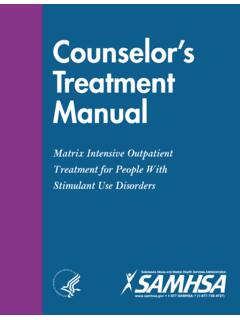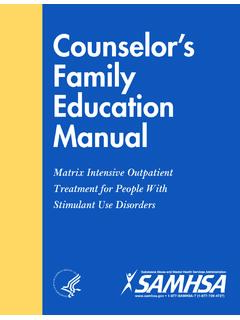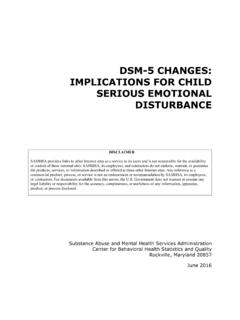Transcription of TIP 57 Trauma-Informed Care in Behavioral Health Services
1 A TREATMENT IMPROVEMENT PROTOCOL. Trauma-Informed Care in Behavioral Health Services TIP 57. A TREATMENT IMPROVEMENT PROTOCOL. Trauma-Informed Care in Behavioral Health Services TIP 57. DEPARTMENT OF Health AND HUMAN Services . Substance Abuse and Mental Health Services Administration Center for Substance Abuse Treatment 1 Choke Cherry Road Rockville, MD 20857. Trauma-Informed Care in Behavioral Health Services Acknowledgments This publication was produced under contract numbers 270-99-7072, 270-04-7049, and 270 . 09-0307 by the Knowledge Application Program (KAP), a Joint Venture of The CDM Group, Inc., and JBS International, Inc., for the Substance Abuse and Mental Health Services Administration (SAMHSA), Department of Health and Human Services (HHS).
2 Andrea Kopstein, , , Karl D. White, , and Christina Currier served as the Contracting Officer's Representatives. Disclaimer The views, opinions, and content expressed herein are the views of the consensus panel members and do not necessarily reflect the official position of SAMHSA or HHS. No official support of or endorsement by SAMHSA or HHS for these opinions or for the instruments or resources described are intended or should be inferred. The guidelines presented should not be considered substitutes for individualized client care and treatment decisions. Public Domain Notice All materials appearing in this volume except those taken directly from copyrighted sources are in the public domain and may be reproduced or copied without permission from SAMHSA or the authors.
3 Citation of the source is appreciated. However, this publication may not be reproduced or distributed for a fee without the specific, written authorization of the Office of Communications, SAMHSA, HHS. Electronic Access and Copies of Publication This publication may be ordered or downloaded from SAMHSA's Publications Ordering Web page at Or, please call SAMHSA at 1-877-SAMHSA-7 (1-877-726 . 4727) (English and Espa ol). Recommended Citation Substance Abuse and Mental Health Services Administration. Trauma-Informed Care in Behavioral Health Services . Treatment Improvement Protocol (TIP) Series 57. HHS Publication No. (SMA) 13-4801. Rockville, MD: Substance Abuse and Mental Health Services Administration, 2014.
4 Originating Office Quality Improvement and Workforce Development Branch, Division of Services Improvement, Center for Substance Abuse Treatment, Substance Abuse and Mental Health Services Administration, 1 Choke Cherry Road, Rockville, MD 20857. HHS Publication No. (SMA) 14-4816. First Printed 2014. ii Please share your thoughts about this publication by completing a brief online survey at: The survey takes about 7 minutes to complete and is anonymous. Your feedback will help SAMHSA develop future products. Contents Consensus vii KAP Expert Panel and Federal Government Participants ..ix What Is a TIP? ..xi xiii How This TIP Is Organized .. xv Terminology ..xvi PART 1: A PRACTICAL GUIDE FOR THE PROVISION OF Behavioral .
5 Health Services .. 1. Chapter 1 Trauma-Informed Care: A Sociocultural Perspective .. 3. Scope of the TIP .. 4. Intended 4. Before You Begin .. 4. Structure of the 6. What Is trauma ?.. 7. trauma Matters in Behavioral Health 7. Trauma-Informed Intervention and Treatment 11. As You Proceed .. 32. Chapter 2 trauma Awareness ..33. Types of 33. Characteristics of trauma .. 46. Individual and Sociocultural 52. Chapter 3 Understanding the Impact of trauma ..59. Sequence of trauma Reactions .. 60. Common Experiences and Responses to 61. Subthreshold trauma -Related Symptoms .. 75. Specific trauma -Related Psychological 77. Other trauma -Related and Co-Occurring Disorders .. 85. iii Trauma-Informed Care in Behavioral Health Services Chapter 4 Screening and Assessment.
6 91. Screening and Assessment .. 92. Barriers and Challenges to Trauma-Informed Screening and Assessment .. 99. Cross-Cultural Screening and 103. Choosing 104. Trauma-Informed Screening and 106. Concluding 110. Chapter 5 Clinical Issues Across Trauma-Informed Prevention and Treatment Objectives .. 111. Treatment Issues .. 127. Making Referrals to trauma -Specific 135. Chapter 6 trauma -Specific Services ..137. Introduction .. 137. trauma -Specific Treatment Models .. 139. Integrated Models for 147. Emerging Interventions .. 153. Concluding 155. PART 2: AN IMPLEMENTATION GUIDE FOR Behavioral Health . PROGRAM Chapter 1 Trauma-Informed Organizations ..159. Strategy #1: Show Organizational and Administrative Commitment to 161.
7 Strategy #2: Use Trauma-Informed Principles in Strategic Planning .. 162. Strategy #3: Review and Update Vision, Mission, and Value 162. Strategy #4: Assign a Key Staff Member To Facilitate Change .. 163. Strategy #5: Create a Trauma-Informed Oversight Committee .. 163. Strategy #6: Conduct an Organizational Self-Assessment of Trauma-Informed Services .. 164. Strategy #7: Develop an Implementation 164. Strategy #8: Develop Policies and Procedures To Ensure Trauma-Informed Practices and To Prevent Retraumatization .. 166. Strategy #9: Develop a Disaster 166. Strategy #10: Incorporate Universal Routine Screenings .. 167. Strategy #11: Apply Culturally Responsive Principles .. 167. Strategy #12: Use Science-Based 169.
8 Strategy #13: Create a Peer-Support 169. Strategy #14: Obtain Ongoing Feedback and Evaluations .. 170. Strategy #15: Change the Environment To Increase 171. Strategy #16: Develop Trauma-Informed Collaborations .. 171. Chapter 2 Building a Trauma-Informed Workforce ..173. Introduction .. 173. Workforce Recruitment, Hiring, and 174. iv Contents Training in TIC .. 177. Trauma-Informed Counselor Competencies .. 181. Counselor Responsibilities and 182. Clinical Supervision and Consultation .. 191. Secondary Traumatization .. 193. Counselor 205. Appendix A Bibliography ..215. Appendix B trauma Resource Appendix C Historical Account of Appendix D Screening and Assessment Instruments ..271. Appendix E Consumer Appendix F Organizational Assessment for Trauma-Informed Appendix G Resource Panel.
9 289. Appendix H Field Reviewers ..293. Appendix I Cultural Competence and Diversity Network Participants ..299. Appendix J Acknowledgments ..300. EXHIBITS. Exhibit : TIC Framework in Behavioral Health Services Sociocultural Perspective .. 6. Exhibit : A Social-Ecological Model for Understanding trauma and Its Effects .. 15. Exhibit : Understanding the Levels Within the Social-Ecological Model of trauma and Its 16. Exhibit : Cross-Cutting Factors of 26. Exhibit : trauma Examples .. 35. Exhibit : Immediate and Delayed Reactions to trauma .. 62. Exhibit : Cognitive Triad of Traumatic Stress .. 67. Exhibit : DSM-5 Diagnostic criteria for ASD .. 78. Exhibit : DSM-5 Diagnostic criteria for 82. Exhibit : ICD-10 Diagnostic criteria for ptsd .
10 85. Exhibit : Important Treatment Facts About ptsd and Substance Use 89. Exhibit : Grounding Techniques .. 98. Exhibit : Key Areas of trauma Screening and 105. Exhibit : SLE 107. Exhibit : STaT: Intimate Partner Violence Screening Tool .. 108. Exhibit : PC- ptsd 108. Exhibit : The SPAN .. 108. Exhibit : The ptsd 109. Exhibit : Resilience Scales .. 110. Exhibit : OBSERVATIONS: A Coping 119. v Trauma-Informed Care in Behavioral Health Services Exhibit : TIC Planning Guidelines .. 165. Exhibit : Clinical Practice Issues Relevant to Counselor Training in trauma - informed Treatment 179. Exhibit : Guidelines for Training in Mental Health Interventions for trauma . Exposed 180. Exhibit : Trauma-Informed Counselor Competencies Checklist.
